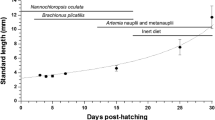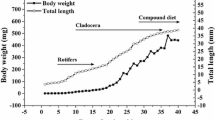Abstract
Laboratory-reared red drum (Sciaenops ocellatus) larvae were used to evaluate the potential of chymotrypsin as an indicator of nutritional condition in marine fish larvae. The response of chymotrypsin activity to food deprivation and reductions in nutrient intake was determined. Enzyme activity declined rapidly to undetectable levels in food-deprived larvae 6–18 days old. Larvae fed poor-quality live prey (starved rotifers, Brachionus plicatilis) exhibited reductions in growth (18%) and enzyme activity (84%) relative to larvae fed high-quality prey (enriched rotifers). Potential sources of variation in chymotrypsin activity unrelated to nutritional status, including diel periodicity, and exogenous enzymes sources were examined. A diel pattern in chymotrypsin activity was detected with an 8.7-fold increase in activity occurring from low to high points during a 24-h period. Highest activity levels occurred late in the day (1600 hours) and lowest activity in the morning prior to feeding (0800 hours). The estimated contribution of exogenous enzymes from prey in the digestive tract to measurements of larval enzyme activity was small, reaching a maximum of 4.1% on day 18 in well-fed larvae. Results indicate that exogenous enzymes will not lead to the misclassification of larvae in poor condition. A relationship between chymotrypsin activity and standard length was established for well-fed and food-deprived larvae that could potentially be used to determine the nutritional condition of wild-caught larvae.










Similar content being viewed by others
References
Applebaum S, Perez R, Lazo JP, Holt GJ (2003) Characterization of chymotrypsin activity during early ontogeny of larval red drum (Sciaenops ocellatus). Fish Physiol Biochem (in press)
Arnold CR (1988) Controlled year-round spawning of red drum (Sciaenops ocellatus) in captivity. Contrib Mar Sci 30 (Suppl):65–70
Ásgeirsson B, Bjarnason JB (1991) Structural and kinetic properties of chymotrypsin from Atlantic cod (Gadus morhua). Comparison with bovine chymotrypsin. Comp Biochem Physiol B 99:327–335
Blaxter JHS (1986) Development of sense organs and behaviour of teleost larvae with special reference to feeding and predator avoidance. Trans Am Fish Soc 115:98–114
Buckley LJ (1984) RNA/DNA ratio: an index of larval fish growth in the sea. Mar Biol 80:291–298
Buckley LJ, Dillman DW (1982) Nitrogen utilization by larval summer flounder, Paralichthys dentatus (Linnaeus). J Exp Mar Biol Ecol 59:243–256
Clement GE, Bender ML (1963) The effect of aprotic dipolar organic solvents on the kinetics of alpha-chymotrypsin-catalysed hydrolysis. Biochemistry 2:836–843
Dabrowski K (1982) Proteolytic enzyme activity decline in starving fish alevins and larvae. Environ Biol Fish 7:73–76
Dabrowski K, Glogowski J (1977) A study of the application of proteolytic enzymes to fish food. Aquaculture 12:349–360
Diaz MF, Moyano J, Garcia-Carreno FL, Alarcon FJ, Sarasquete MC (1997) Substrate-SDS-PAGE determination of protease activity through larval development in sea bream. Aquacult Int 5:461–471
Drescher KC (1995) Investigation of the RNA:DNA ratios of laboratory reared and field caught larval red drum (Sciaenops ocellatus). Master's thesis, University of Texas at Austin
Evjemo JO, Danielsen TL, Olsen Y (2001) Losses of lipid, protein and n-3 fatty acids in enriched Artemia franciscana starved at different temperatures. Aquaculture 193:65–80
Ferron A, Leggett WC (1994) An appraisal of condition measures for marine fish larvae. Adv Mar Biol 30:217–303
Garcia-Ortega A, Verreth J, Segner H (2000) Post-prandial protease activity in the digestive tract of African catfish Clarias gariepinus larvae fed decapsulated cysts of artemia. Fish Physiol Biochem 22:237–244
Govoni JJ, Boehlert GW, Watanabe Y (1986) The physiology of digestion in fish larvae. Environ Biol Fish 16:59–77
Heath MR (1992) Field investigations of the early life stages of marine fish. Adv Mar Biol 28:2–174
Hjelmeland K, Huse I, Jørgensen T, Molvik G, Raa J (1984) Trypsin and trypsinogen as indices of growth and survival potential of cod (Gadus morhua L.) larvae. In: Dahl E, Danielssen DS, Moksness E, Solemdal P (eds) The propagation of cod, Gadus morhua, part 1. Institute of Marine Research, Flødevigen Biological Station, Arendal, Norway, pp 189–202
Hjort J (1914) Fluctuations in the great fisheries of northern Europe viewed in the light of biological research. Rapp P-v Reun Const Int Explor Mer 20:1–228
Holt GJ (1993) Feeding larval red drum on microparticulate diets in a closed recirculating water system. J World Aquacult Soc 24:225–230
Holt GJ, Holt SA (2000) Vertical distribution and the role of physical processes in the feeding dynamics of two larval sciaenids Sciaenops ocellatus and Cynoscion nebulosus. Mar Ecol Prog Ser 193:181–190
Houde ED (1987) Fish early life dynamics and recruitment variability. Am Fish Soc Symp 2:17–29
Hummel BCW (1959) A modified spectrophotometric determination of chymotrypsin, trypsin, and thrombin. Can J Biochem Physiol 37:1393–1399
Hunter JR (1984a) Feeding ecology and predation of marine fish larvae. In: Lasker R (ed) Marine fish larvae. University of Washington Press, Seattle, pp 33–79
Hunter JR (1984b) Inferences regarding predation on the early life stages of cod and other fishes. In: Dahl E, Danielssen DS, Moksness E, Solemdal P (eds) The propagation of cod, Gadus morhua, part 1. Institute of Marine Research, Flødevigen Biological Station, Arendal, Norway, pp 533–562
Kurokawa T, Shiraishi M, Suzuki T (1998) Quantification of exogenous protease derived from zooplankton in the intestine of Japanese sardine (Sardinops melanostictus) larvae. Aquaculture 161:491–499
Lauff M, Hofer R (1984) Proteolytic enzymes in fish development and the importance of dietary enzymes. Aquaculture 37:335–346
Lazo JP, Holt G, Arnold C (2000) Ontogeny of pancreatic enzymes in larval red drum Sciaenops ocellatus. Aquacult Nutr 6:183–192
Leggett WC, Deblois E (1994) Recruitment in marine fishes: is it regulated by predation and starvation in the egg and larval stage? Neth J Sea Res 32:119–134
MacKenzie BR, Ueberschär B, Basford D, Heath D, Gallego A (1999) Diel variability of feeding activity in haddock (Melanogrammus aeglefinus) larvae in the East Shetland area, North Sea. Mar Biol 135:361–368
Makridis P, Olsen Y (1999) Protein depletion of the rotifer Brachionus plicatilis during starvation. Aquaculture 174:343–353
Munilla-Moran R, Stark JR, Barbour A (1990) The role of exogenous enzymes in digestion in cultured turbot larvae (Scophthalmus maximus L.). Aquaculture 88:337–350
Øie G, Olsen Y (1997) Protein and lipid content of the rotifer Brachionus plicatilis during variable growth and feeding condition. Hydrobiologia 358:251–258
Olsen Y, Reitan KI, Vadstein O (1993) Dependence of temperature on loss rates of rotifers, lipids, and omega-3 fatty acids in starved Brachionus plicatilis cultures. Hydrobiologia 255:13–20
Pedersen BH, Andersen KP (1992) Induction of trypsinogen secretion in herring larvae (Clupea harengus). Mar Biol 112:559–565
Pedersen BH, Nilssen EM, Hjelmeland K (1987) Variations in the content of trypsin and trypsinogen in larval herring (Clupea harengus) digesting copepod nauplii. Mar Biol 94:171–181
Pedersen BH, Ugelstad I, Hjelmeland K (1990) Effects of transitory low food supply in the early life of larval herring (Clupea harengus) on mortality, growth and digestive capacity. Mar Biol 107:61–66
Rainuzzo JR, Reitan KI, Olsen Y (1994) Effect of short- and long-term lipid enrichment on total lipids, lipid class and fatty acid composition in rotifers. Aquacult Int 2:19–32
Rice JA, Crowder LB, Binkowski EP (1987) Evaluating potential sources of mortality for larval bloater Coregonus hoyi: starvation and vulnerability to predation. Can J Fish Aquat Sci 44:467–472
Ronnestad I, Conceicao LEC, Aragao C, Dinis MT (2000) Free amino acids are absorbed faster and assimilated more efficiently than protein in postlarval Senegal sole (Solea senegalensis). J Nutr 130:2809–2812
Rooker JR, Holt GJ (1996) Application of RNA:DNA ratios to evaluate the condition and growth of larval and juvenile red drum (Sciaenops ocellatus). Mar Freshw Res 47:283–290
Rooker JR, Holt SA (1997) Utilization of subtropical seagrass meadows by newly settled red drum Sciaenops ocellatus: patterns of distribution and growth. Mar Ecol Prog Ser 158:139–149
Sale PF (1990) Recruitment of marine species: is the bandwagon rolling in the right direction? Trends Ecol Evol 5:25–27
Stryer L (1988) Biochemistry. Freeman, New York
Ueberschär B (1993) Measurement of proteolytic enzyme activity: significance and application in larval fish research. In: Walther BT, Fhyn HJ (ed) Physiological and biochemical aspects of fish development. University of Bergen, Norway
Ueberschär B (1995) The use of tryptic enzyme activity measurement as a nutritional condition index: laboratory calibration data and field application. ICES Mar Sci Symp 201:119–129
Ueberschär B, Clemmesen C (1992) A comparison of the nutritional condition of herring larvae as determined by two biochemical methods—tryptic enzyme activity and RNA/DNA ratio measurements. ICES J Mar Sci 49:245–249
Underwood AJ, Fairweather PG (1989) Supply-side ecology and benthic marine assemblages. Trends Ecol Evol 4:16–20
Vonk HJ, Western JRH (1984) Comparative biochemistry and physiology of enzymatic digestion. Academic Press, London
Acknowledgements
The authors wish to thank Juan Pablo Lazo, Sharon Herzka, Cynthia Faulk, and Rafael Perez for assistance and helpful suggestions. This work was supported by grants from the Sid W. Richardson Foundation and the Texas Higher Education Coordinating Board Advanced Research Program. The experiments presented here comply with current laws of the United States.
Author information
Authors and Affiliations
Corresponding author
Additional information
Communicated by P.W. Sammarco, Chauvin
Rights and permissions
About this article
Cite this article
Applebaum, S.L., Holt, G.J. The digestive protease, chymotrypsin, as an indicator of nutritional condition in larval red drum (Sciaenops ocellatus). Marine Biology 142, 1159–1167 (2003). https://doi.org/10.1007/s00227-003-1041-8
Received:
Accepted:
Published:
Issue Date:
DOI: https://doi.org/10.1007/s00227-003-1041-8




